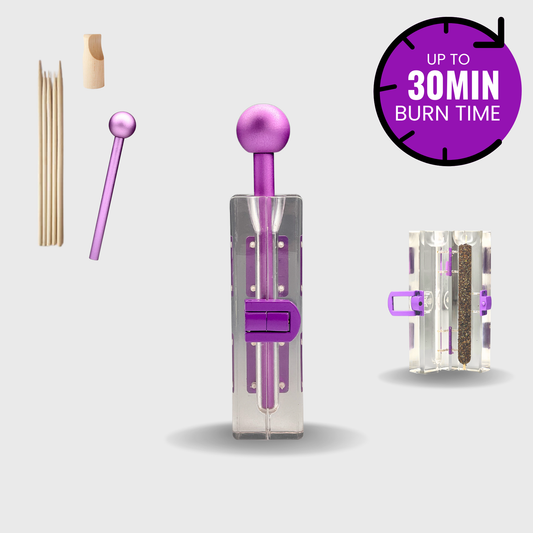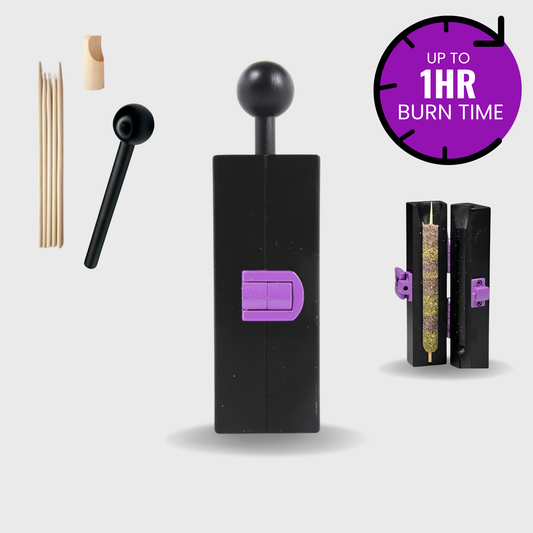Thai Sticks: The Origin of Cannagars
Whether you’re rolling your cannabis flower in a blunt, spliff, or filling up a joint cone, your experience will be great. But, if you’re looking for an especially sublime method of enjoying cannabis, cannagars should be your top choice.

Simply put, a cannagar is a cigar that is all cannabis. So, instead of a tobacco core and tobacco leaf wrapper, cannabis is used!
A cannagar is one way of smoking cannabis unique from other cannabis rolls like blunts, joints, and spliffs. This option is popular for special occasions like weddings or outdoor barbeques because of how long cannagars burn.
Just like with actual tobacco cigars, cannabis cigars burn slow. The inside contains a hefty amount of densely compressed cannabis around a wooden skewer. Cannabis cigars seem like they would burn hot or feel overwhelming to hit. But because of the skewer inside, a hollow chamber is created through the center of the cannagar. You’ll get a steady airflow to move through the cannabis core as you inhale and take pulls. So not only do cannagars burn slowly, the rolls offer an even, velvety-smooth full-flavor cannabis smoking experience.
Depending on the size you choose and the number of people partaking, cannabis cigars can burn for literal hours. So, it makes sense that cannabis cigars are the perfect choice for cannabis-friendly events or hangouts. You’ll be able to pass it around, and it won’t become a roach after a few rotations of your circle.
Around the cannabis community, people describe cannagars as giant blunts — and it’s easy to see why the comparison exists. However, cannagars are more closely related to Thai Sticks.
Thai Sticks: The Origin of Cannagars

Thai Sticks are essentially the original cannagars, though they’re often referred to as cannagars today. Originating from Thailand is what gives the “Thai” in Thai Sticks. They made their way to the United States in the ’70s from Veterans after the Vietnam War. While Thai Sticks are dipped in hash oil today, it’s believed it used to be opium.
The process of creating a Thai Stick is similar to a cannabis cigar. First, you compress large amounts of cannabis around a bamboo skewer or hemp stalk, then wrap with cannabis leaves. Next, the cigar is bound with thread or wick to keep the mold in place and then vacuum-sealed to cure.
How Are Cannagars Made?

Make a Cannagar by compressing large amounts of cannabis around a wooden stick skewer (like the ones for shish kebabs). Next, the cannabis core is taken from the mold and wrapped securely in cannabis or hemp fan leaves. You can coat the fan leaves in concentrates, then dip in kief. Similar to Thai Sticks, cannabis cigars are tied together with hemp wick and sometimes stored in a mason jar to cure.
Once ready, the cannabis cigar may need a torch or lighter to spark the initial cherry. Pulling from the cigar is easy because of the small hollow opening in the center of the cannagar core.
Want to learn how to make a cannagar for yourself? You can find our detailed, step-by-step tutorials on our website! Our process is easy to follow, and we even offer cannagar kits to help you create your very own roll.
Is a Cannagar a Blunt?

While cannagars and blunt rolls are both known for their slow-burning smoking sessions, the two offer unique experiences. Blunts traditionally include a ground cannabis core rolled inside an emptied cigar or cigarillo. Cannabis cigars are usually far more complex.
For example, a cannagar core is compressed and hollowed to allow airflow throughout the cigar. This process is more involved and takes longer to accomplish than simply rolling a blunt. And, the result is often a much steadier, easy-to-hit roll — mainly since pre-rolled cannagars also commonly include mouthpieces.
We always include mouthpieces with our kits, allowing you to get the full experience from home.
Furthermore, blunt wraps come from tobacco leaves. They give your high an energy spike but also make the smoke harsher and overpower the taste of your flower. Cannabis cigar wraps, on the other hand, are actual cannabis leaves that can be coated with kief and concentrate. You could just as easily include kief or wax inside your blunt. But the taste and effects will be different compared to a cannagar with multiple layers of leaf wraps.
Blunts have the potential to be quite elaborate. Depending on the dedication and enthusiasm of the person rolling, of course. But a basic blunt won’t compare to the experience of a cannagar. And eliminating steps or pieces from the cannagar process will leave you with a lackluster example of the cigar.
In short, here’s the differences between blunts and cannagars:

What's the Difference Between Joints and Cannagars?

Joints are one of the most popular and well-known ways to consume cannabis. You can roll your cannabis inside paper made from hemp, rice, or bamboo. Joints can be made with a roller, by hand, or filled with cannabis through the top of a cone. Filters at the end of joints act as a mouthpiece and help hold the fragile joint paper’s shape. They also prevent small bits of cannabis (or “Scooby Snacks”) from sticking in your mouth as you inhale.
Joints can be big or small. They’re easy to light and hit. And since they burn quickly, joints are an efficient way of consuming cannabis.
Additionally, joints provide a better flavor profile of the flower than a blunt might. And joints are often less harsh than blunts. However, joints aren’t ideal for more than three people unless it contains more than a few grams. They can quickly lose their cherry if a breeze happens to blow in just the right direction.
They also tend to “run” where one side burns faster than the other. And, joints can burn through more cannabis than one might realize in-between taking hits or passing it around. But the way you cure your flower often has more to do with this than the joint itself.
Joints vs Cannagars
When choosing between cannagars versus joints, your decision should factor in the activity and the number of people. A cannagar brings a sense of style and elegance to a party, whereas a joint is classic and iconic. Joints will likely leave you disappointed, wishing you had chosen something like a cannagar that’s more durable and slow-burning. It’s especially true if you want to share with multiple people or a large-sized group.
Here’s a quick run-down of the differences between cannagars versus joints:

Spliffs Vs Cannagars

Spliffs are similar to joints, except they contain cut tobacco mixed with cannabis inside a rolling paper. This helps ensure they burn evenly and won’t self-extinguish in the middle of a session. They are also easier to roll than joints. Cannabis texture can be inconsistent, so the tobacco can help give the spliff a uniform shape. Since spliffs commonly have crutches, pulling hits is almost seamless — the keyword here being “almost.”
By inhaling more tobacco with spliffs than blunts, spliffs are harsh and more like a cigarette than joints or blunts. In addition, the flavor of the spliff might be more tobacco intensive than a blunt. So you’ll miss out on the cannabis flavor profile that a cannagar can offer you. And while a spliff might burn longer than a joint, a cannagar will still out-burn both. Not to mention you’re not consuming tobacco carcinogens when puffing on a cannagar versus a spliff.

Purple Rose Supply: Hooking You Up With a Personalized Cannagar Experience

Cannagars earn a reputation for being an expensive, over-the-top, novelty cannabis product. But cannagars should be known for the blissful experience they offer. You’ll find your new favorite way of smoking cannabis with our high-quality, affordable, and fully customizable cannagar kits. We even created a short cannagar quiz to help you choose the ideal size for how you enjoy cannabis.
When making your cannagar, the possibilities are only as limited as your imagination. At Purple Rose Supply, we have the tools and tips to help you craft the Mona Lisa of cannabis rolls.
Want to learn more? Check out this video on Joints vs Blunts
Ready to make your own? Browse our cannagar kits.





5 comments
Yeah I’ve wanted to get into this and finally found some info!
This may be a stupid question, do I leave the skewer in or take it out .
Beautifully explained and lovely written as well. I enjoyed reading and I think you should be able to find more content like this on the web. I think cannabis marketing agency are doing the fine job of that.
Had some of the original “Thai” stick in 1973. The one laced with opium was called “Buddha Stick”. We never smoked them like cannagars. I was on a tugboat, too many eyes watching. We’d unwrap them and smoke them in zigzags. Good memories. Vietnam wasn’t all bad.
Love it. Bout one then 2 more different sizes